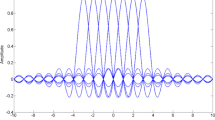Abstract
The principle target of an International Mobile Telecommunication (IMT) is to build a platform to advance the improvement of technology used in 5G and to inspire the support with the MNCs and organizations. The journey of 5th Generation initiated with 1G technology and has provided a massive improvement in today’s world. 5G technology on IMT provides the target to achieve ultra-high data rate, connectivity, reliability, lower latency, and lower data traffic. The usage of Orthogonal Frequency-Division Multiplexing (OFDM) system in 4G technology causes high Peak-to-Average Power Ratio (PAPR), complexity, and out-of-band radiation. To avoid these parameters, Filtered (F)-OFDM is exploited in 5G technology. The design becomes complex by the division of spectrum into non-contiguous spectrum fragments. So, resource block F-OFDM system using Internet of Things is proposed to convert non-contiguous spectrum into contiguous spectrum but the complexity remains the same. The proposed work of this paper is IoT-based RB-F-OFDM system along with inverse fast Walsh-Hadamard and Fourier transform to decrease the complexity and also, adaptive filter is exploited for retaining the actual (regular) grid to avoid signal information required for specifying a particular subband in the spectrum. Also, to enhance the quality of service, spectrum efficiency and cognitive radio system are used along with these techniques. Simulation result shows that proposed RB-Adaptive Filtered (AF)-OFDM provides low PAPR, high signal-to-interference ratio, and low bit error rate performance. The proposed RB-AF-OFDM system has the benefits of both RB-F-O FDM and adaptive F-OFDM so it further reduces the PAPR and complexity to the considerable value which is around 2.5.















Similar content being viewed by others
References
Boussakta S, Holt AGJ (1989) Fast algorithm for calculation of both Walsh-Hadamard and Fourier transforms (FWFTs). Electron Lett 25(20):1352–1354
Zhang X, Chen L, Jia M, Qiu J, Ma J (2015) Filtered-OFDM–enabler for flexible waveform in the 5th generation cellular networks. In: Proceedings IEEE global communication conference, San Diego
Wu D, Zhang X, Qiu J, Gu L, Saito Y, Benjebbour A, Kishiyama Y (2016) A field trial of F-OFDM towards 5G. 2016 IEEE GLOBECOM workshop, pp 1–6
Li J, Bala E, Yang R (2014) Resource block filtered-OFDM for future spectrally agile and power efficient systems, physical communication, vol 11, pp 36–55
Li J, Kearney K, Yang R, Bala E (2013) A resource block based filtered OFDM scheme and performance comparison. In: Proceedings of IEEE ICT, pp 1–5
Weitkemper P, Bazzi J, Kusume K (2016) Adaptive filtered OFDM with regular resource grid. Communications workshops
Zhu X, Pan W, Li H, Tang Y (May 2013) Simplified approach to optimized iterative clipping and filtering for PAPR reduction of OFDM signals. IEEE Trans Commun 61(5):1891–1901
Wang YC, Luo ZQ (2011) Optimized iterative clipping and filtering for PAPR reduction of OFDM signals. IEEE Trans Commun 59(1):33–37
Ghassemi A, Gulliver TA (2009) Intercarrier interference reduction in OFDM systems using low complexity selective mapping. IEEE Trans Commun 57(6):1608–1611
Chen H, Liang H (2007) Combined selective mapping and binary cyclic codes for PAPR reduction in OFDM systems. IEEE Trans Wirel Commun 6(10):3524–3528
Chung KC, Yang TY, Chen H (2015) Low complexity PTS algorithms with error correction capability in OFDM systems. In: Proceedings of 7th conference Ubiquitous Future Network, Sapporo, Japan, pp 254–256
Kang C, Liu Y, Hu M, Zhang H (2017) A low complexity PAPR reduction method based on FWFT and PEC for OFDM systems. IEEE Trans Broadcast 63(2):416–425
Hamood MT, Boussakta S (2011) Fast Walsh Hadamard Fourier transform algorithm. IEEE Trans Sig Process 59(11):5627–5631
Daher A, Burel G, Baghious EH, Radoi E (2010) Overlap-save and overlap-add filters: optimal design and comparison. IEEE Trans Signal Process 58(6):3066–3075
Akyildiz IF, Mohanty S, Lee WY, Vuran MC (2006) Next generation/dynamic spectrum access/cognitive radio wireless networks: a survey. Comput Netw 50(13):2127–2159
Muller SH, Huber JB (1997) OFDM with reduced peak to average power ratio by optimum combination of partial transmit sequences. IEEE Electron Lett 33(5):368–369
Muller SH, Bauml RW, Huber JB, Ficsher RFH (Jan 1997) OFDM with reduced peak-to-average power ratio by multiple signal representation. Ann Telecommun 52(1–2):58–67
Bauml RW, Fischer RFH, Huber JB (1996) Reducing the peak to average power ratio of multi carrier modulation by selective mapping. IEEE Electron Lett 32:2056–2057
Cherubini G, Eleftheriou E, Olcer S (2002) Filtered multitone modulation for very high-speed digital subscriber lines. IEEE J Sel Areas Commun 20(5):1016–1028
Tonello AM, Pecile F (2007) A filtered multitone modulation modem for multiuser power line communications with an efficient implementation. In: Proceedings of IEEE international symposium on Power Lines Communication and Its Apps., ISPLC, pp 155–160
Tonello AM, Pecile F (2009) Efficient architectures for multiuser FMT systems and applications to power line communications. IEEE Trans Commun 57(5):1275–1279
Dong L, Zhao H, Chen Y, Chen D, Wang T, Lu L, Zhang B, Hu L, Gu L, Li B, Yang H, Shen H, Tian T, Luo Z, Wei K (2017) Introduction on IMT-2020 5G trails in China. IEEE J Sel Areas Commun 35(8):1849–1866
Author information
Authors and Affiliations
Corresponding author
Additional information
Publisher’s note
Springer Nature remains neutral with regard to jurisdictional claims in published maps and institutional affiliations.
Rights and permissions
About this article
Cite this article
Ajitha, C., Jaya, T. Cognitive radio technology with reduced PAPR and complexity for IoT-based OFDM networks. Peer-to-Peer Netw. Appl. 13, 2065–2077 (2020). https://doi.org/10.1007/s12083-019-00820-5
Received:
Accepted:
Published:
Issue Date:
DOI: https://doi.org/10.1007/s12083-019-00820-5




